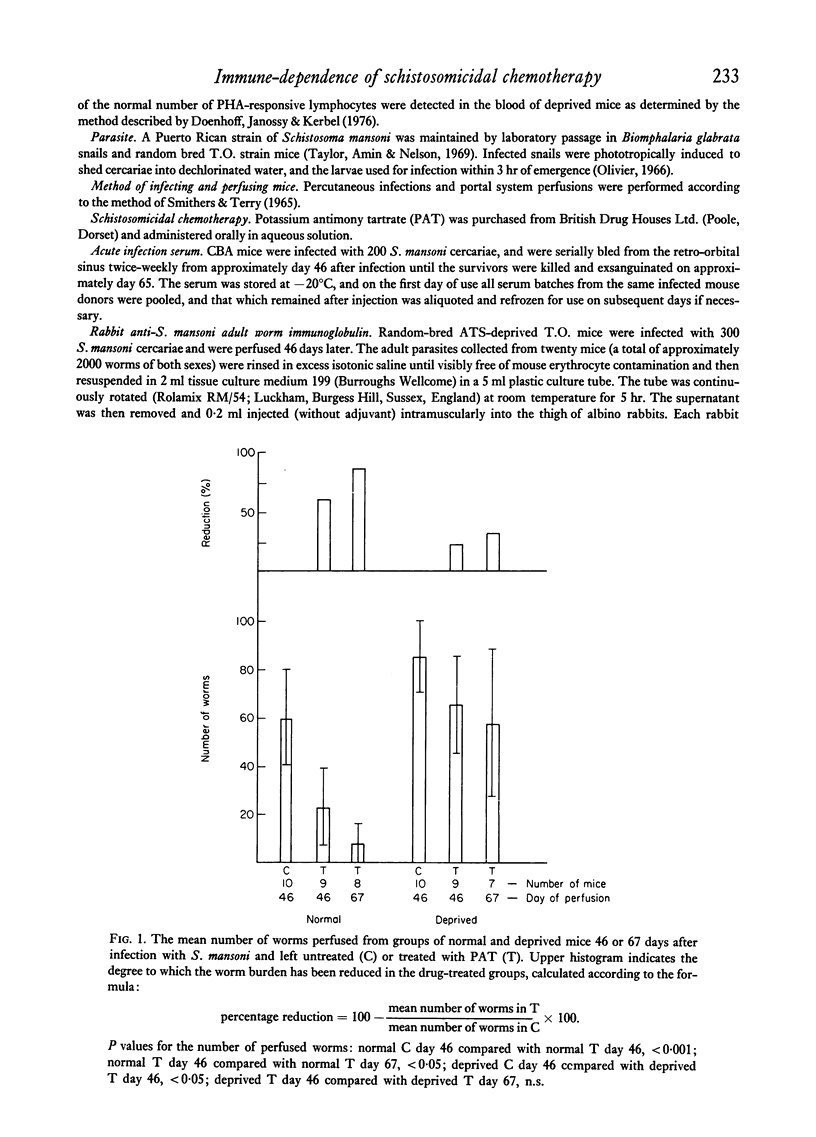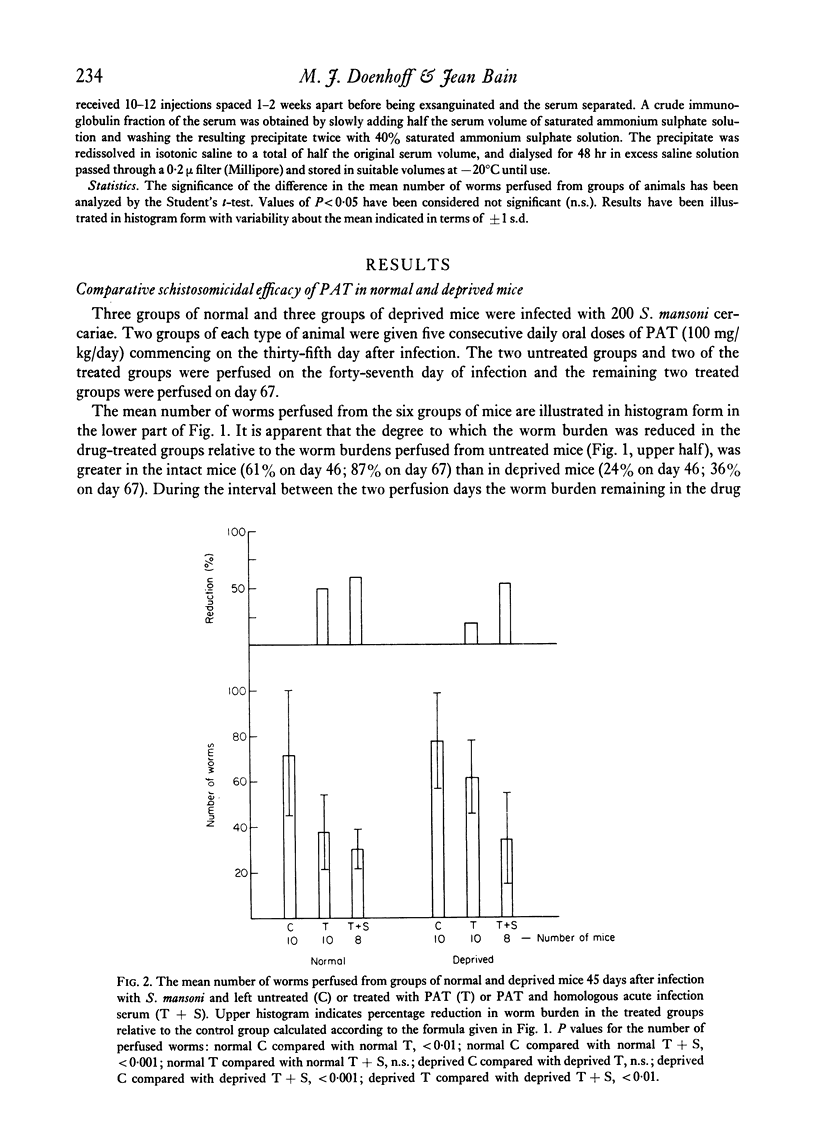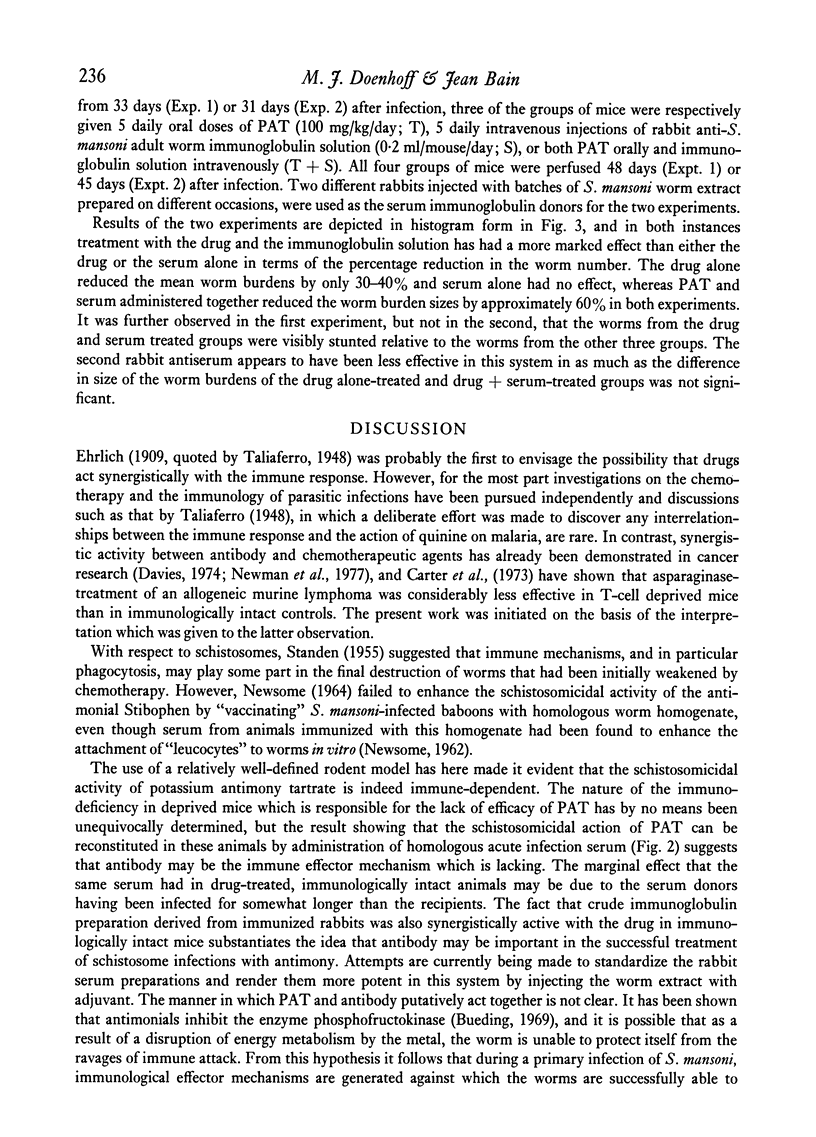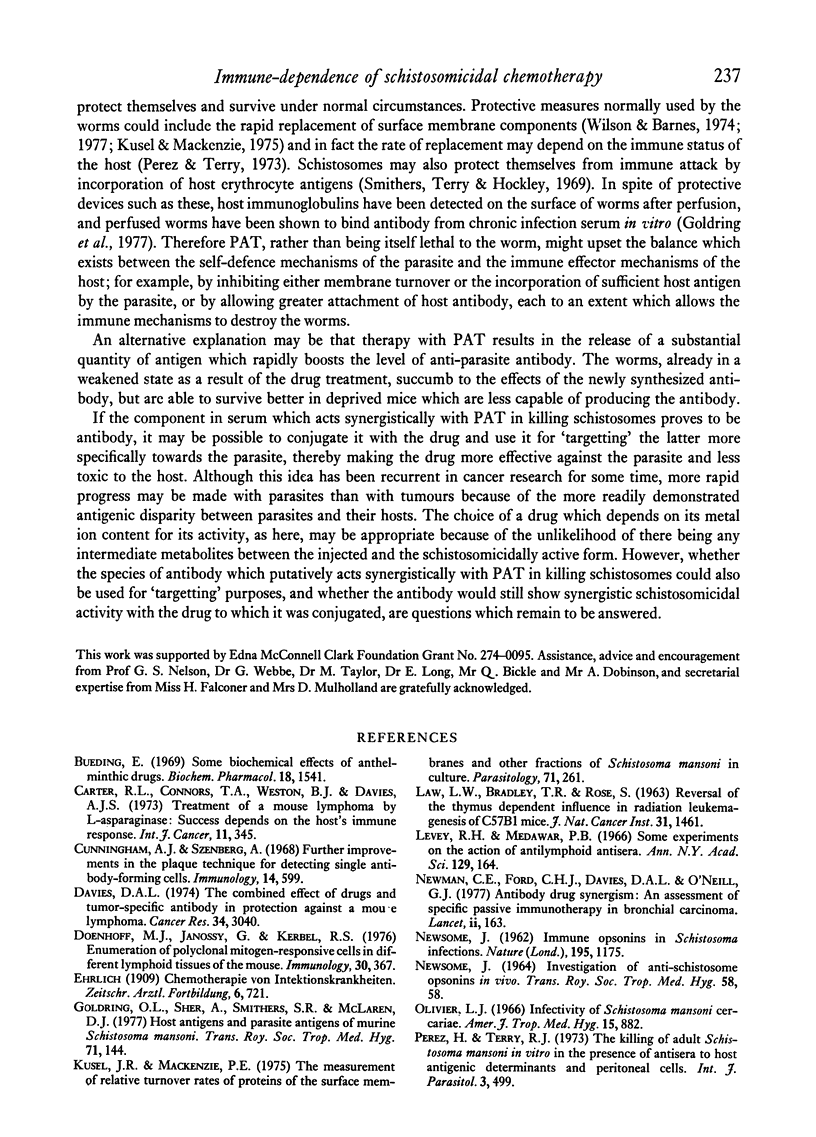Abstract
When T-cell deprived CBA mice, infected with Schistosoma mansoni, were treated orally with potassium antimony tartrate, the reduction in size of their worm burdens was less than in similarly treated, immunologically-intact animals. The defect in deprived mice could be restored by the administration of serum obtained from S. mansoni-infected normal mice simultaneously with the drug, but by a different route. A serum component, probably immunoglobulin, obtained from rabbits which had been injected with an extract from S. mansoni adult worms was also found to act synergystically with the antimonial in the chemotherapeutic eradication of S. mansoni worms from immunologically intact mice.
Full text
PDF






Selected References
These references are in PubMed. This may not be the complete list of references from this article.
- Bueding E. Some biochemical effects of anthelmintic drugs. Biochem Pharmacol. 1969 Jul;18(7):1541–1547. doi: 10.1016/0006-2952(69)90140-3. [DOI] [PubMed] [Google Scholar]
- Carter R. L., Connors T. A., Weston B. J., Davies A. J. Treatment of a mouse lymphoma by L-asparaginase: success depends on the host's immune response. Int J Cancer. 1973 Mar 15;11(2):345–357. doi: 10.1002/ijc.2910110212. [DOI] [PubMed] [Google Scholar]
- Cunningham A. J., Szenberg A. Further improvements in the plaque technique for detecting single antibody-forming cells. Immunology. 1968 Apr;14(4):599–600. [PMC free article] [PubMed] [Google Scholar]
- Davies D. A. The combined effect of drugs and tumor-specific antibodies in protection against a mouse lymphoma. Cancer Res. 1974 Nov;34(11):3040–3043. [PubMed] [Google Scholar]
- Doenhoff M. J., Janossy G., Kerbel R. S. Enumeration of polyclonal mitogen-responsive cells in different lymphoid tissues of the mouse. Immunology. 1976 Mar;30(3):367–378. [PMC free article] [PubMed] [Google Scholar]
- Goldring O. L., Sher A., Smithers S. R., McLaren D. J. Host antigens and parasite antigens of murine Schistosoma mansoni. Trans R Soc Trop Med Hyg. 1977;71(2):144–148. doi: 10.1016/0035-9203(77)90083-9. [DOI] [PubMed] [Google Scholar]
- Kusel J. R., Mackenzie P. E. The measurement of the relative turnover rates of proteins of the surface membranes and other fractions of Schistosoma mansoni in culture. Parasitology. 1975 Oct;71(2):261–273. doi: 10.1017/s0031182000046709. [DOI] [PubMed] [Google Scholar]
- LAW L. W., BRADLEY T. R., ROSE S. REVERSAL OF THE THYMUS-DEPENDENT INFLUENCE IN RADIATION LEUKEMOGENESIS OF C57BL MICE. J Natl Cancer Inst. 1963 Dec;31:1461–1477. [PubMed] [Google Scholar]
- NEWSOME J. INVESTIGATION OF ANTI-SCHISTOSOME OPSONINS IN VIVO. Trans R Soc Trop Med Hyg. 1964 Jan;58:58–62. doi: 10.1016/0035-9203(64)90069-0. [DOI] [PubMed] [Google Scholar]
- NEWSOME J. Immune opsonins in Schistosoma infestations. Nature. 1962 Sep 22;195:1175–1179. doi: 10.1038/1951175a0. [DOI] [PubMed] [Google Scholar]
- Newman C. E., Ford C. H. Antibody-drug synergism: An assessment of specific passive immunotherapy in bronchial carcinoma. Lancet. 1977 Jul 23;2(8030):163–166. doi: 10.1016/s0140-6736(77)90180-5. [DOI] [PubMed] [Google Scholar]
- Olivier L. J. Infectivity of Schistosoma mansoni cercariae. Am J Trop Med Hyg. 1966 Nov;15(6):882–885. doi: 10.4269/ajtmh.1966.15.882. [DOI] [PubMed] [Google Scholar]
- Perez H., Terry R. J. The killing of adult Schistosoma mansoni in vitro in the presence of antisera to host antigenic determinants and peritoneal cells. Int J Parasitol. 1973 Jul;3(4):499–503. doi: 10.1016/0020-7519(73)90046-5. [DOI] [PubMed] [Google Scholar]
- STANDEN O. D. The progress of degenerative changes in schistosomes following the treatment of experimental infections with 1:7-bis (p-dimethylaminophenoxy) heptane. Trans R Soc Trop Med Hyg. 1955 Sep;49(5):416–423. doi: 10.1016/0035-9203(55)90005-5. [DOI] [PubMed] [Google Scholar]
- Smithers S. R., Terry R. J. The infection of laboratory hosts with cercariae of Schistosoma mansoni and the recovery of the adult worms. Parasitology. 1965 Nov;55(4):695–700. doi: 10.1017/s0031182000086248. [DOI] [PubMed] [Google Scholar]
- Wilson R. A., Barnes P. E. An in vitro investigation of dynamic processes occurring in the schistosome tegument, using compounds known to disrupt secretory processes. Parasitology. 1974 Apr;68(2):259–270. doi: 10.1017/s0031182000045777. [DOI] [PubMed] [Google Scholar]
- Wilson R. A., Barnes P. E. The formation and turnover of the membranocalyx on the tegument of Schistosoma mansoni. Parasitology. 1977 Feb;74(1):61–71. doi: 10.1017/s0031182000047533. [DOI] [PubMed] [Google Scholar]


